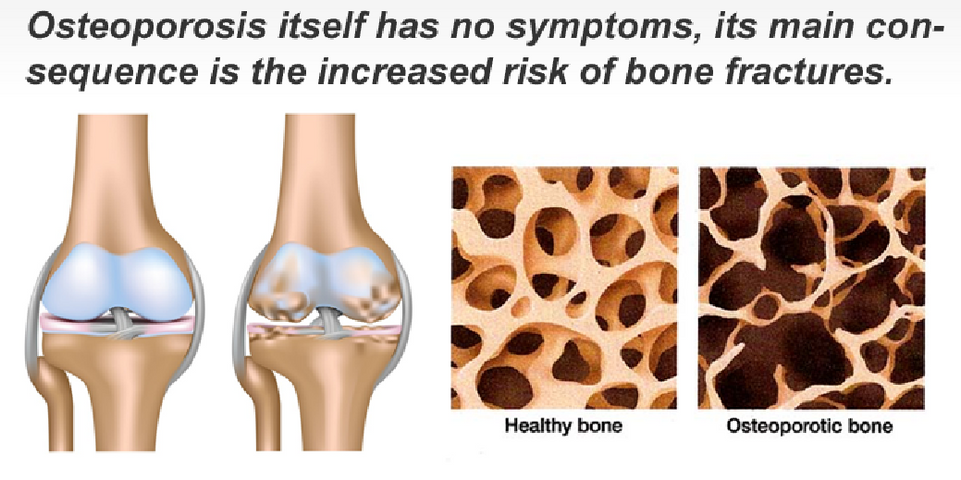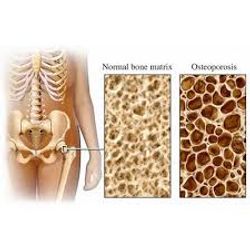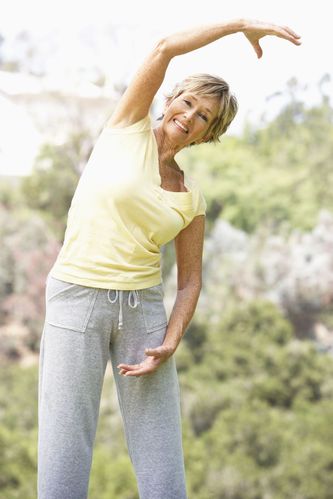Osteoporosis - Silent but Effective if not Managed

Osteoporosis occurs – And we do not even realize it!
What is osteoporosis?
Osteoporosis is a condition where the bones lose minerals such as calcium which causes them to become fragile and brittle, and they are therefore more prone to fracture. Osteoporosis can affect any bone in the body, but is most common in the spine, hips and wrists. Usually no symptoms will be felt until a fracture (break or crack in the bone) occurs. Often these fractures can occur with minimal trauma such as a fall.

What causes osteoporosis?
Our bodies are constantly building new bone, and removing old bone. In childhood, more bone is built than is removed so our bone mass grows, as we get into our 30’s and 40’s more bone is removed than is being added, so our bone mass can start to decline. Another cause of osteoporosis is a lack of certain hormones such as estrogen in women and androgen in men. Menopause, which causes a lowering of women’s estrogen can be a contributing factor to osteoporosis.
Other factors which can contribute to osteoporosis include lack of calcium and vitamin D intake, lack of weight bearing exercise, thyroid problems, lack of muscle use (inactivity), cigarette smoking, anorexia or bulimia, heavy alcohol consumption, rheumatoid arthritis and bone cancer.
There are not usually any symptoms of osteoporosis until you have a fracture, in this case the fracture (often from relatively mild trauma) will give pain or deformity. Deformity often happens when the weakened vertebra in the spine are crushed and a hump in the spine starts to form, like when the back starts to appear hunched over which is often called a dowagers hump.
What can I do to prevent osteoporosis or slow its progression?
Osteoporosis prevention and management can take many forms
- Reduce alcohol consumption
- Quit smoking (or reduce intake of tobacco smoke)
- Improve your diet – ensure you have a balanced diet of vitamins and minerals including calcium and vitamin D (vitamin D can also be obtained with exposure to sunlight)
- Maintain a healthy weight – being underweight can lead to osteoporosis
- Increase weight bearing activity – such as weights, walking, running, body resistance training. Peak bone mass is usually achieved by 25 years of age, so it is important to achieve strong bones by that age so that bones will stay strong later in life.
- Reduce intake of soft drink – some studies have shown that soft drinks may increase risk of osteoporosis
- Consult with your healthcare provider and they can order a bone mineral density test if warranted to check for signs of osteoporosis, if you already have osteoporosis your healthcare provider can prescribe medication to help maintain or improve your bone mass, however you still need to exercise and eat correctly.

What is a BMD test?
Traditional X-rays can’t measure bone density, but they can identify spine fractures. Bone mineral density (BMD) has to be measured by more specialized techniques. A number of different types of BMD tests are available, but the most commonly used is DXA (dual-energy X-ray absorptiometry)
DXA is a low radiation X-ray capable of detecting quite small percentages of bone loss. It is used to measure spine and hip bone density, and can also measure bone density of the whole skeleton.
A DXA scan, which is used to measure spine and hip bone density, is the most common technique for assessing the risk of osteoporosis.
What do my test results mean?
The World Health Organization has defined a number of threshold values (measurements) for osteoporosis. The reference measurement is derived from bone density measurements in a population of healthy young adults (called a T-score). Osteoporosis is diagnosed when a person’s BMD is equal to or more than 2.5 standard deviations below this reference measurement.
Osteopenia is diagnosed when the measurement is between 1 and 2.5 standard deviations below the young adult reference measurement.
| Status | Hip BMD |
| Normal | T-score of -1 or above |
| Osteopenia | T-score lower than -1 and greater than -2.5 |
| Osteoporosis | T-score of -2.5 or lower |
| Severe osteoporosis | T-score of -2.5 or lower, and presence of at least one fragility fracture |
If the results of your BMD test show osteopenia or osteoporosis, it does not automatically mean that you will have a fracture. There are lifestyle changes and a number of available therapies that your doctor might prescribe to slow down bone loss and help prevent fractures.
Where can I start my osteoporosis screenings?
The Center for Women in Baxter County, AR, has offered obstetrics and gynecology services, including regular women’s health exams, counseling, and pregnancy health care, since 2001. They accept new patients and offer same- or next-day appointments for urgent issues, so you can rest assured they’ll be there when you need them most. Call the Mountain Home-based clinic at (870) 425-7300 to schedule an appointment, or visit the website for information on their additional offerings.
About the Business
Have a question? Ask the experts!
Send your question

